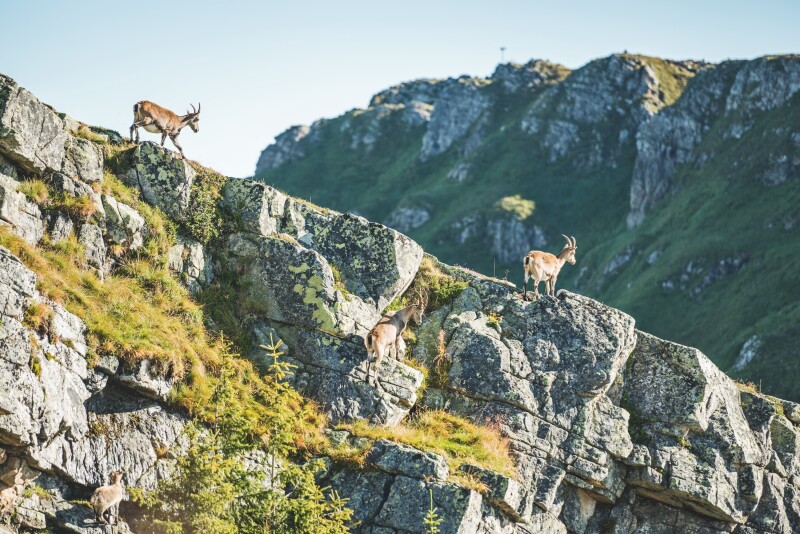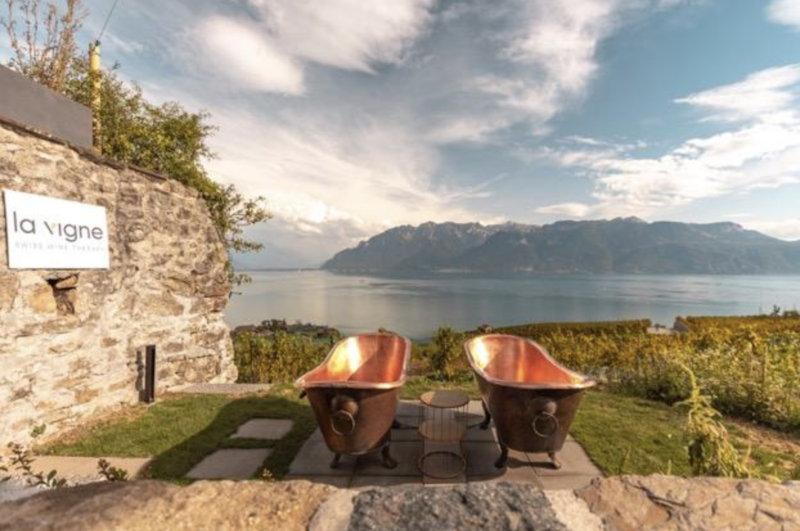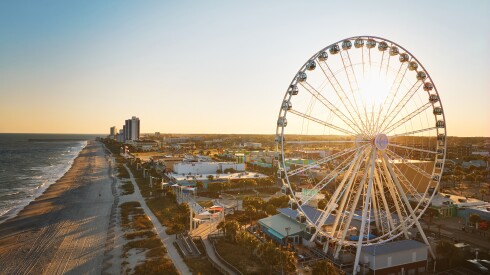You might think the best time to visit Switzerland is in winter for skiing or summer for hiking. But in autumn, as tree leaves and vineyards turn a golden hue, it’s one of Europe’s best under-the-radar destinations.
Crisp temperatures and fall foliage create a dreamy setting for distinctive experiences. Imagine flower-adorned cattle descending from Alpine pastures, taking part in a traditional wine harvest, browsing contemporary art spaces, and spotting ibex on dramatic ridges. Plus, you’ll have the trails practically to yourself with fewer crowds. Make the most of the season’s unhurried pace with a slow-travel approach to seeing Switzerland.
See a cattle descent—and attend cheese festivals
Mid-September brings the country’s most beloved autumn tradition. The Alpabzug or Désalpe is when flower-adorned cattle, sheep, and goats come down from mountain pastures to valleys below, marking the end of the grazing season and the beginning of fall’s beauty. Dairy farmers in traditional costumes lead their herds decorated with flowers. In some regions, the nearly 300-year-old ceremony divides cheese among farmers to celebrate the end of Alpine summer. Cattle festivals go hand in hand (or hoof in hoof) with Chästeilet (or cheese festivals), like the one in Thun.
Insider tip: Step into a fairytale at 12th-century Thun Castle, then wander Thun’s enchanting Old Town and lakeside Schadau Park—home to a Gothic Revival castle that’s a national treasure. It doesn’t get more Swiss than this.Insider tip: Step into a fairytale at 12th-century Thun Castle, then wander Thun’s enchanting Old Town and lakeside Schadau Park—home to a Gothic Revival castle that’s a national treasure. It doesn’t get more Swiss than this.
Take a mountain railway to a leisurely hike

Fronalpstock at sunset.
Courtesy of Stoosbahnen AG/Carole Volkart
From Lucerne, two spectacular mountain railways offer autumn hiking adventures amid valleys blazing with the colors of the season. The Stoosbahn—the world’s steepest funicular at 110 percent gradient (47 degrees)—climbs to the car-free village of Stoos for wildflower-dotted meadow walks and panoramic ridge trails, including some that are easily accessible.
Mount Rigi’s cogwheel trains ascend the “Queen of Mountains” for sweeping Alpine vistas. Once you’ve reached the summit, explore one of the many hiking trails within reach. Those feeling extra ambitious may even consider descending like the cattle—on foot.
Take a scenic train journey connecting Lucerne to Interlaken
In under two hours, the Lucerne Interlaken Express unfolds as a kaleidoscopic adventure. Gliding past five pristine alpine lakes and dramatic cliffs, the train climbs using cogwheel technology en route to the 3,307-foot Brünig Pass and connecting the Bernese Oberland to Central Switzerland. Consider spending ample of time in Lucerne and Interlaken. These iconic destinations not only offer must-see excursions like the Jungfraujoch - Europe’s highest trainstation - and Lucerne’s Chapel Bridge but also many off the beaten path gems.
Hike, bike, and sip wine in Vaud’s vineyards
In Vaud’s UNESCO-listed Lavaux Vineyard (nearly 2,000 acres between Montreux and Lausanne), terraced vines cascade from Lake Geneva’s shimmering shores with snow-capped peaks on the horizon, creating one of the world’s most stunning wine regions. During early October’s harvest, when golden Chasselas grapes are at their plump and juicy peak, explore medieval villages and 10th-century stone walls on foot, like on a 6.8-mile hike from St. Saphorin to Lutry, and visit cellars aboard the Lavaux Express train. For the ultimate immersive experience, volunteer as a vigneron (winemaker or cultivator) and stay overnight at unique vineyard accommodations.
Pro tip: Every winery hosts harvest-end celebrations, but you’ll need luck with timing as each operates independently, and harvest dates vary from year to year. Contact the local tourist office ahead of your trip to see if you can assist with the harvest and join a celebration.
See pumpkin art and taste pumpkin delicacies
Just outside Zürich, Jucker Farm is home to Switzerland’s largest pumpkin exhibition from late September through November. It features elaborate, larger-than-life depictions of favorite movie characters, wildlife, and other fantastical sculptures composed of hundreds of orange gourds.
Beyond picture-worthy displays, you’ll find picture-worthy dishes. Pumpkin spaghetti, anyone? Try the seasonal menus at these nine restaurants, as well as the seeded pretzels available at most train stations.
Take a cold plunge in Swiss waters
This landlocked nation has no shortage of bodies of water. Or bodies in water—people enjoy taking a dip outdoors year-round. “Every one of Switzerland’s cities has a great river to swim in—often on lunch hours, sometimes even to commute,” writes Afar contributor Bonnie Tsui. Summer is the most popular for lakeside swimming (see Zürich’s best badis for swimming), and autumn marks the start of the cold-plunge season. The pristine lakes and alpine rivers offer an invigorating chill for brave souls seeking a thrill.
Join a guided Ibex-watching hike along Switzerland’s Niederhorn ridge

Two ibex scale rock ledges along the Niederhorn ridge near Interlaken.
Courtesy of Switzerland Tourism
Near Interlaken, professional guides lead ibex-watching excursions along Niederhorn ridge, where these sure-footed climbers with distinctive ridged horns (descendants of animals smuggled from Italy after Swiss extinction a century ago) navigate dramatic cliff faces. Keep your eyes peeled—and binoculars handy—for goat-like chamois, bearded vultures, and beavers against the stunning backdrop of Eiger, Mönch, Jungfrau, and the steep Justistal Valley below.
Relax at a nature spa

Courtesy of Switzerland Tourism/Elena Schmid
For those seeking self-care, Switzerland’s nature spas offer a peaceful retreat. Picture sipping Chasselas wine while soaking in copper tubs overlooking Lavaux vineyards or relaxing in Alpine hot tubs surrounded by vibrant fall foliage. From forest bathing and natural pools to sauna boat cruises across glacial lakes, these outdoor wellness experiences let you unwind amid the destination’s most spectacular seasonal colors. If you prefer a luxury indoor spa, visit the 43,000-square-foot spa at the five-star Dolder Grand in Zürich or the nearly 108,000-square-foot Bürgenstock Alpine Spa overlooking Lake Lucerne.
Attend Lausanne’s Bach Festival
Nothing ushers in autumn quite like the rich resonance of cellos and violins echoing through Lausanne’s concert halls during the city’s acclaimed Bach Festival. Running from November 7, 2025, to December 4, 2025, this year’s “Baroque Splendor” theme showcases masterworks in intimate venues across the lakeside city. It’s a lesser-known alternative to summer’s Gstaad Menuhin Festival, and Lausanne offers renowned performances with Lake Geneva’s stunning scenery and tantalizing Lavaux wines within reach.
Meet Zürich’s artisans and explore its celebrated museums and galleries

Pavillon le Corbusier in Zürich.
Courtesy of Switzerland Tourism.
Experience the full spectrum of Zürich’s artistry, from hands-on workshops with local makers to renowned museums. On a Made in Zürich Tour, you’ll visit local artisans, from all-natural, hand-crafted Soeder soaps and a repurposed-plastic atelier to a family-owned watchmaker and Zürich’s cheesemakers.
More culture awaits in the city’s cultural core along its Gallery Mile, a vibrant stretch of contemporary art spaces anchored by Switzerland’s largest art museum, Kunsthaus Zürich, with its Swiss masters and international collections—and a new extension by architect David Chipperfield. Meanwhile, modernist design fans will appreciate the crayon-colored Pavillon Le Corbusier (Le Corbusier’s last building), which explores his visionary work through architecture, art, and philosophy in a serene lakeside setting.











